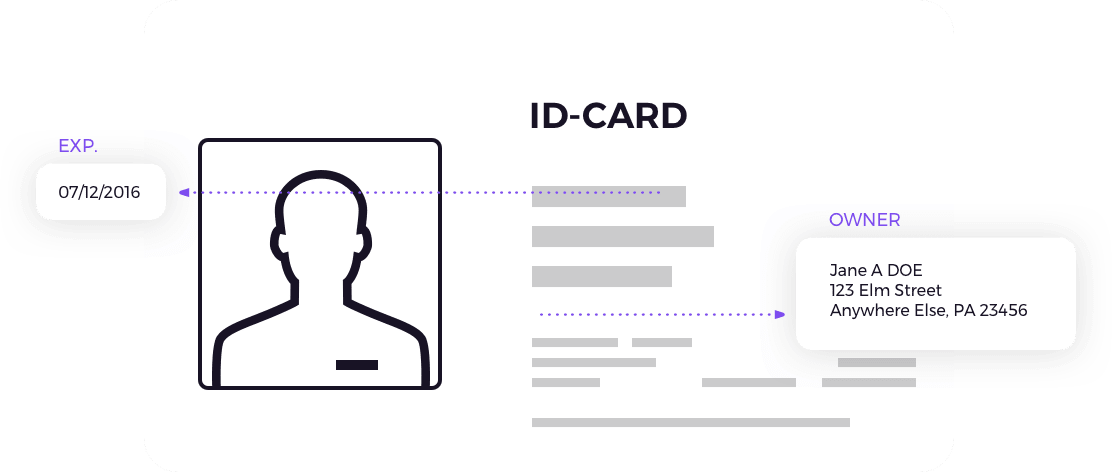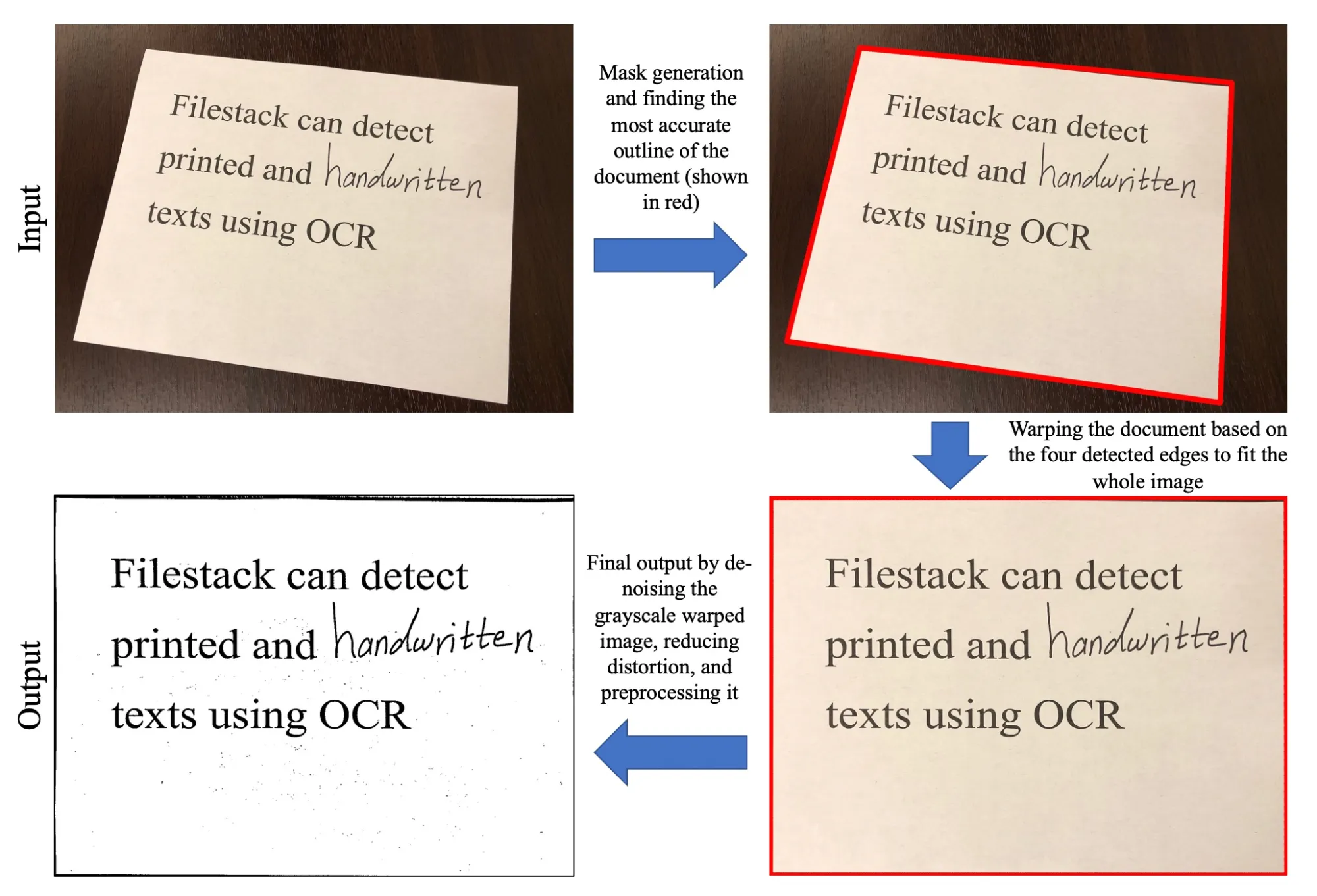OCR is a revolutionary technology that has transformed the document-based data extraction process. OCR is used in various industries, such as healthcare, education, banking, finance, retail, and e-commerce. It helps automate data entry, digitize documents, process invoices automatically, and more. And with the advent of JavaScript OCR APIs, using the OCR technology is super simple and easy. A JavaScript OCR API lets developers easily add strong OCR features to their apps using simple JavaScript code.
However, when choosing an OCR API, assessing its accuracy is essential. For instance, the API’s ability to handle poor-quality documents significantly impacts its accuracy. Moreover, factors like non-standard fonts and handwritten text also affect OCR accuracy.
In this article, we’ll discuss JavaScript OCR use cases and factors you should consider when choosing a JavaScript OCR API. We’ll also introduce you to Filestack’s powerful JavaScript OCR solution, known for its high accuracy and ease of use.
JavaScript OCR API: What is it, and how does it work

OCR is a technology that automates the process of extracting text from printed or handwritten documents and images. In other words, optical character recognition (OCR) can extract text from images/scanned documents and transform it into editable, machine-readable data.
A Javascript OCR API enables you to integrate powerful OCR capabilities into your web apps or websites. Hence, with OCR for web development, developers and businesses can save time and costs for building OCR solutions from scratch.
Today’s OCR engines and solutions are highly accurate. They utilize sophisticated technologies like machine learning and neural networks to provide precise results. For instance, with neural networks, OCR breaks the document into smaller parts. It then runs each part through a neural network individually to determine if it includes a character/letter. OCR then finds the most compatible match, improving the accuracy of the extracted text.
You can use OCR to extract data from:
- Printed and handwritten documents
- Passports
- Driver’s licenses
- Credit cards
- ID cards
- Tax receipts
- PDF documents and more
Innovative use-cases of JavaScript OCR API
OCR is a cornerstone of modern document-based data extraction and information management processes. Today, OCR technology has a wide range of applications in various industries. Here are some common real-world OCR applications.
Document digitization
This is perhaps the biggest benefit of OCR. Using a JavaScript OCR API, you can easily convert printed and handwritten documents into digital formats. These include receipts, invoices, contracts, medical prescriptions and more. You can simply scan your documents and feed them into the OCR system. OCR will then extract text from the documents and convert it into digital data. This enables easy data retrieval and facilitates efficient document management.
Automated invoice processing
An OCR API or text recognition API can be used to automate invoice processing. These APIs can extract accurate data from invoices and convert them into searchable and editable formats. Moreover, efficient OCR APIs can handle different invoice layouts and formats, improving accuracy.
Data entry automation
Using an OCR JavaScript library, businesses can also automate data entry processes. For instance, they can use OCR to recognize text and extract data from documents like forms, handwritten notes, and business cards and populate databases with the extracted data.
Text search
OCR for web apps offers efficient text-based search and analysis capabilities. For instance, users can search for specific phrases or keywords within scanned images. This makes it quicker to find relevant information and organize it.
Documents verification
OCR engine can also serve as a powerful document identification and verification tool. For instance, businesses can use it to verify official documents, driver’s licenses, ID cards, passports, etc.
Healthcare
OCR can prove to be an invaluable tool for the healthcare industry. For instance, healthcare organizations can utilize OCR for:
- Digitizing patients’ records and organizing their data efficiently
- Extracting data and information from insurance claims and verifying the data
- OCR can help pharmacies digitize and read handwritten prescriptions easily and quickly
Education
The education sector can make use of OCR to digitize printed books effortlessly. These books can then be made available on e-learning platforms.
How to choose the right JavaScript OCR API?
With various OCR APIs available in the market, choosing the right API for real-world OCR projects can be challenging. However, considering the following factors can help you make an informed decision:
Data accuracy
Choosing an accurate OCR API is crucial because inaccurate data can result in financial and legal consequences. When assessing the API’s accuracy, consider factors like:
- How well does the JavaScript OCR API handle font variations?
- The API’s ability to handle handwritten text variations.
- Whether the API can accurately read text from a low-resolution or distorted input image/ document.
- Which image formats does the API support?
Multilingual recognition
If you work with documents that have different languages, check if the API can recognize and understand those languages. Not all OCR APIs support multiple languages. However, some efficient APIs are specially configured to recognise a wide range of languages.
Support for specific document types
Assess whether the OCR API is configured and optimized for your specific document types. For example, if you’re dealing with invoices and receipts, choosing a specialized invoice processing API can offer enhanced accuracy of OCR results. Some powerful APIs are optimized for various document types, such as:
- Passports
- Invoices
- ID cards
- Receipts, etc.
Ease of Integration
Look for a JavaScript OCR API that is easy to integrate into your app. A good API has detailed documentation with sample codes, facilitating integration. Some OCR platforms also offer specialized plugins for different JavaScript frameworks.
Processing speed
Considering the processing speed of API is also important. It is especially crucial for apps that require real-time text detection. Some OCR APIs support the processing of multiple images or documents, while others offer blazing-fast single-image processing.
Also Read: OCR performance optimization for enhanced accuracy and performance.
Introducing Filestack JavaScript OCR: A tool for streamlined OCR processing
Filestack is a powerful set of tools and APIs for file upload, transformation, and delivery. It also offers OCR as a part of its processing engine, enabling text extraction with API. Filestack OCR, with its powerful capabilities and accuracy, enables intelligent document processing.
Here are the key features of Filestack OCR:
Various document types support
Filestack supports OCR data extraction from various documents with different fonts and layouts. These include both printed and handwritten documents. For example, with Filestack OCR API, you can extract data from:
- Credit cards
- Passports
- Receipts
- Tax documents
- Invoices
- ID cards
- Driver’s licenses
- Tax documents
- Business cards, and more.

Highly accurate and detailed results
Filestack OCR engine efficiently recognizes and extracts text from images/scanned documents and is known for high accuracy. It provides precise and detailed information about the recognized text. Here are some of the features that make Filestack OCR the best:
Sophisticated document detection and pre-processing solutions
Filestack utilizes state-of-the-art document detection and pres-processing solutions for improved OCR accuracy. that can correct imperfections in scanned documents. The advanced document detection system is backed by supervised and unsupervised machine learning algorithms. It can efficiently detect complex documents, such as folded, rotated, or wrinkled documents. This helps the OCR engine provide accurate results, no matter which type of document you upload for OCR data extraction.
The figure below shows the complete OCR data extraction process:

Image Enhancement Features
Filestack Processing API offers impressive image transformation features. This allows you to enhance your images for OCR data extraction to improve accuracy. For example, you can:
- Improve image quality and upscale images
- Remove noise from images
- Crop images
- Convert the image file to a unified format
- Resize images to standard size
- Compress images
- Apply different image enhancements and filters
Scalable
You can scale the Filestack OCR according to your business needs. The OCR is designed to handle the data extraction needs of both small businesses and large corporations.
Sign up for Filestack and try its OCR today!
Conclusion
A JavaScript OCR API is an invaluable tool for digitizing printed and handwritten documents and automating the data extraction process. It can extract data from images and scanned documents and convert them into searchable and editable formats. Today, there are a wide range of OCR API use cases and applications in various industries, such as:
- Document digitization
- Data entry automation
- Automated invoice processing
- Document verification
- Patitents’ record management
- Converting printed books into digital formats
Frequently Asked Questions (FAQs)
What APIs are used for JavaScript OCR?
Filestack OCR is an example of JavaScript OCR API. It is available as a part of Filestack Processing API.
What are popular OCR applications in the real world?
JavaScript OCR use examples include:
- Document digitization
- Document verification
- Automated data entry
- Automated invoice processing
- Converting printed books into digital formats
- Patitents’ record management
How to use free OCR API?
You can use Filestack OCR API for free by signing up with Filestack to get your API key.
Sidra is an experienced technical writer with a solid understanding of web development, APIs, AI, IoT, and related technologies. She is always eager to learn new skills and technologies.
Read More →
